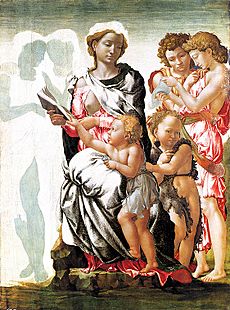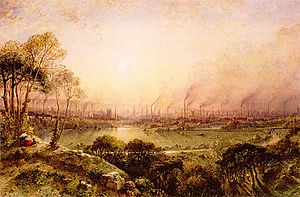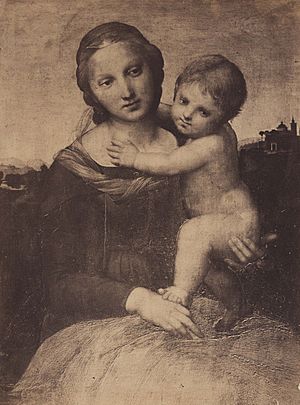Art Treasures Exhibition, Manchester 1857 facts for kids
The Art Treasures of Great Britain was a huge art show held in Manchester, England. It ran from May 5 to October 17, 1857. This was the biggest art exhibition ever in the UK, and maybe even the world! It showed over 16,000 artworks.
More than 1.3 million people visited the exhibition in 142 days. That's about four times the number of people living in Manchester at the time! Many visitors came on special train trips. The way artworks were chosen and displayed at this show really helped shape how public art collections, like the National Gallery and the Victoria and Albert Museum, were set up in the UK.
Contents
Why Manchester Hosted It
Manchester used to be a small town. But by 1855, it had become a big industrial city with 95 cotton mills and many warehouses. A French historian, Alexis de Tocqueville, visited in 1835 and described it as a place where "black smoke covers the city," but also where "the greatest stream of human industry flows out."
Manchester became a city in 1853. Rich business leaders in the city paid for the exhibition. They wanted to show off Manchester's cultural side. They were inspired by other big shows like the Paris International Exhibition in 1855 and the Great Exhibition in London in 1851. But unlike those shows, the Manchester exhibition only displayed art, not industrial goods.
The idea for the exhibition started with a letter in February 1856 from John Connellan Deane. He had helped with the Dublin Exhibition in 1853. He wrote to Thomas Fairbairn, whose father owned an iron factory in Manchester. The idea quickly grew! About 100 people promised money to help pay for it, and Queen Victoria and Prince Albert supported the project.
A main committee was set up in May 1856. It was led by Lord Ellesmere and later by Lord Overstone. John Connellan Deane was put in charge as the General Commissioner. They also got advice from famous art experts like German art historian Gustav Friedrich Waagen. George Scharf became the exhibition's Art Secretary. He later became the first director of the new National Portrait Gallery.
The Exhibition Building
The exhibition was held outside the city center in Old Trafford. It was built on a three-acre site that used to be a cricket ground. The Manchester Cricket Club moved to a new location nearby. The site was perfect because it was next to the Manchester Botanical Garden and a railway line. The railway company even built a new station, now called Old Trafford tram stop, for the thousands of visitors.
The builders, C.D. Young & Co., created a temporary building made of iron and glass. It was similar to the famous Crystal Palace in London. The building was about 656 feet long and 200 feet wide. It had a large central hall with arched roofs and narrower sections on the sides. The main design is thought to be by Francis Fowke, who also designed the Natural History Museum in London. A fancy brick entrance was designed by local architect Edward Salomons. They used a lot of iron, glass, and 1.5 million bricks to build it!
Inside, the building had a huge hall with space for an orchestra and a large pipe organ. Each iron column had the exhibition's special symbol: "ATE." The hall was divided into different art galleries. The inside walls were covered with wood panels and fabric. Most of the inside decorations were done by John Gregory Crace. The roofs had glass sections that let in lots of natural light. In summer, they put shades over the glass to protect the art and even sprayed water on the roof to keep it cool!
Above the entrance, a line from a poem by John Keats was written: "A thing of beauty is a joy for ever." By the exit, there was a line from Alexander Pope: "To wake the soul by tender strokes of art."
The hall also had two public places to eat, called First Class and Second Class. An American writer, Nathaniel Hawthorne, visited and described people in the Second Class room eating "vast quantities of cold boiled beef."
Artworks on Display

The exhibition showed over 16,000 artworks, divided into 10 groups. These included:
- Paintings by old masters (famous artists from the past).
- Paintings by modern masters.
- British portraits and tiny paintings called miniatures.
- Watercolour drawings.
- Sketches and original drawings.
- Engravings (printed pictures).
- Photographs, including pictures from the Crimean War.
- Works of art from Asia.
- Sculptures.
The collection had 5,000 paintings and drawings by "Modern Masters" like Hogarth, Gainsborough, Turner, and the Pre-Raphaelites. It also had 1,000 works by European Old Masters, such as Rubens, Raphael, Titian, and Rembrandt. There were hundreds of sculptures and other decorative arts like Wedgwood china, Sèvres porcelain, Venetian glass, and armor. The committee even bought a collection of medieval and Renaissance art from Jules Soulages for £13,500 to be a main part of the show.
The artworks were arranged in order of time, to show how art developed. Works from northern Europe were on one wall, and works from southern Europe from the same time were on the wall opposite. Even though there was art from Europe and Asia, the exhibition focused a lot on British artworks.
Most public art collections in Britain were just starting. So, most of the artworks were borrowed from 700 private collections. Many of these had never been shown to the public before. The exhibition included the Madonna and Child with Saint John and the Angels, which had only recently been thought to be by Michelangelo. Seeing this unfinished work caused a lot of excitement, and it's still known as the Manchester Madonna. A French art critic said that "Manchester's collection is worth almost as much as the Louvre's."
Not all private owners wanted to lend their art. The Duke of Devonshire reportedly refused, saying, "What in the world do you want with art in Manchester? Why can't you stick to your cotton spinning?"
Visitors to the Show
Prince Albert officially opened the exhibition on May 5, 1857. Queen Victoria visited on June 29 and 30. The exhibition stayed open until October 17, 1857. It was closed on October 7 for a "day of sadness" because of the Indian Mutiny happening at the time.
Tickets were sold in advance. Daily tickets cost half a crown for the first 10 days and on Thursdays, and 1 shilling on other days. They tried lowering the price to sixpence after 2 p.m. on Saturdays to encourage working-class visitors, but it didn't bring in much more money.
The exhibition attracted more than 1.3 million visitors. Famous people who visited included the King of Belgium, the Queen of the Netherlands, Charles Dickens, Alfred Lord Tennyson, Florence Nightingale, Elizabeth Gaskell, John Ruskin, and Nathaniel Hawthorne. Titus Salt, a factory owner, even paid for three trains to bring 2,600 of his workers from Saltaire to visit. Many other train trips were organized from towns all over England. Thomas Cook, who was famous for organizing tours, even arranged "moonlight" trips from Newcastle.
Friedrich Engels, a famous thinker, wrote to Karl Marx about the exhibition, saying, "Everyone up here is an art lover just now and the talk is all of the pictures at the exhibition."
To entertain visitors, Charles Hallé organized an orchestra to perform daily concerts. After the exhibition closed, he continued running the orchestra, which became the famous Hallé Orchestra. There was also a temporary "Art Treasure Hotel" for visitors to stay overnight.
The exhibition led to several publications, including a large catalogue and weekly magazines. There was even a small booklet called "The Operative's Guide to the Manchester Art Treasures Exhibition," aimed at factory workers.
The exhibition made money from ticket sales and selling catalogues. It also earned money from the cloakroom and food sales.
What Happened After
The exhibition made a small profit of about £304. This was a good result, especially compared to the Dublin Exhibition, which lost a lot of money. The railway company that brought visitors to the site made a much bigger profit, about £50,000!
After the exhibition ended, all the artworks were returned to their owners. The temporary building and its contents were sold off. The glass display cases were bought by new museums being built in London. The building was completely taken down by November 1858. The materials from the building, which cost over £37,000 to build, sold for only about £7,000.
The site where the exhibition stood later became part of the Manchester Botanical Gardens. It was used for another exhibition in 1887 to celebrate Queen Victoria's 50 years on the throne. The gardens closed in 1907 and became a fun park called White City Pleasure Gardens.
The Manchester exhibition became a model for how art was displayed in public galleries later in the 1800s. Even though the artworks went back to private owners, many of them ended up in public collections over the years. The National Portrait Gallery in London, which opened in 1858, arranged its displays in chronological order, just like the Manchester exhibition had done.
A smaller art exhibition was held in Folkestone in 1886. A large painting exhibition was also held in Bethnal Green, an industrial part of London, starting in 1872. This one was specifically designed to attract working-class visitors.
To celebrate 150 years since the exhibition, the Manchester Art Gallery held a special show in 2007–08. A conference was also held at the University of Manchester in November 2007.
See Also
- Great Exhibition
- Exposition Universelle (1855)
- The Crystal Palace




